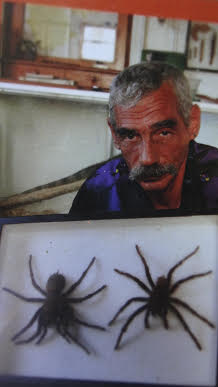Theraphosa apophysis
| Theraphosa apophysis | ||||||||||||
|---|---|---|---|---|---|---|---|---|---|---|---|---|

Theraphosa apophysis |
||||||||||||
| Systematics | ||||||||||||
|
||||||||||||
| Scientific name | ||||||||||||
| Theraphosa apophysis | ||||||||||||
| ( Tinter , 1991) |
Theraphosa apophysis , sometimes also called the Venezuela giant tarantula in German, is one of the three described species of the genus Theraphosa . It is one of the largest known spiders.
distribution
The species occurs almost exclusively in the south of Venezuela up to the border regions of Brazil and Guyana .
Size and appearance
Adult females reach a height of 12 cm and can reach a leg span of up to 30 cm. Adult males, however, reach a size of 5–7 cm. Theraphosa apophysis comes in different colors from light brown tones to black. The carapace is partly colored pink, which can be seen particularly clearly after the moult.
The specific epithet apophysis is derived from the tibial apophyses (shin hooks) of the sexually mature males, who have them in contrast to the males of Theraphosa blondi and Theraphosa stirmi . Another difference to the other two types is the stridulation hair on the hips (coxes) of the first two pairs of legs.
Biology and way of life
The spiders live in the tropical rainforest in self-dug earth tunnels, the walls of which are partially papered with spider silk. The habitats are characterized by high temperatures (also in the shade of the forest over 30 ° C) and striking rainy and dry seasons. The earth tubes reach a depth of up to one meter. The spiders hunt ground-living arthropods and small vertebrates from the mouth of their burrow. In the mating season, in the field after the rainy season, from around the end of October to December, the males leave their burrows and roam around in search of females. Copulation occurs before the female is built. Two to three months later, the female lays eggs in a brood sac . During this time, she expanded the building and closed its entrance with spider silk. The brood sac is covered with stripped stinging hairs from the abdomen of the female, which offer some protection against parasitoids . The young hatch in the Eisack and moult twice until the female releases them. They remain in the maternal structure until their cuticle has hardened and then disperse.
behavior
Theraphosa apophysis is a bombardier spider . It defends itself by shedding its stinging hair and, in contrast to other species, bombs much more strongly. Contact with the skin can cause itching. Also the stridulate is hard to miss in this species. Otherwise, Theraphosa apophysis is considered a peaceful representative of its genus and only bites very rarely. She is considered voracious.
Web links
Theraphosa apophysis in the World Spider Catalog
swell
- riesenvogelspinnen.com Theraphosa-apophysis
- vogelspinnenforum.ch Theraphosa apophysis, January 2, 2007
- reptile-food.ch Theraphosa-apophysis
- arachnophilia.de Theraphosa-apophysis